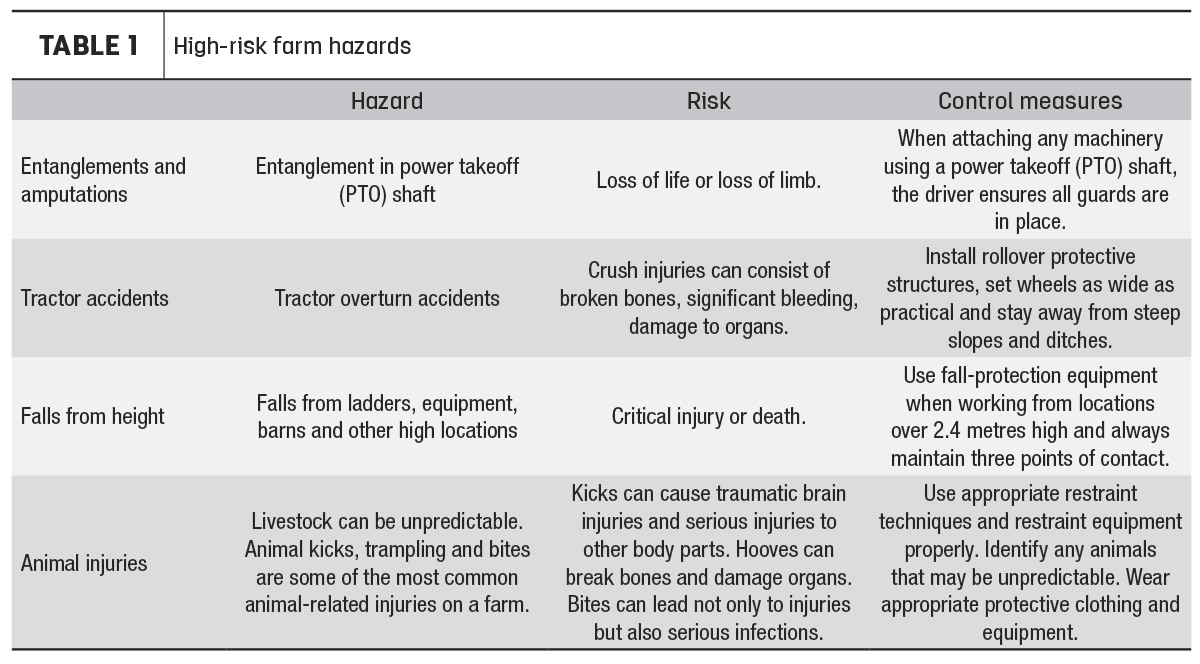Now that you have discussed your dairy’s commitment to health and safety with your farm team and set up your health and safety board, the next step in the process towards developing a solid health and safety program on your dairy is to identify the tasks that pose the highest risk hazards to your team and then develop a safe operating procedure you can use to train your team on how to conduct the task safely.
What is a high-risk hazard?
According to the Merriam-Webster Dictionary, the definition of high risk is: likely to result in failure, harm or injury, or more likely than others.
When assessing the risk level of an activity, assess the severity of the harm, injury or abuse: whether it is trivial (little to no effect), minor (requiring first aid), moderate (sprains, strains, referral to a doctor or one to six days of lost time) or intolerable (major injury including seven days of lost time, disastrous results, life changing injury or trauma). Also assess the likelihood of an accident, injury or abuse: whether it be improbable (unlikely to occur), possible (likely to occur) or probable (risk will occur).
What is a hazard?
A hazard is any source of possible damage, injury or harmful health effects on something or someone. Sometimes the resulting harm is referred to as the hazard instead of the actual source of the hazard. For example, cancer may be called a hazard by some, but in reality, cigarettes or smoking would be considered the hazard.
Types of hazards
A common way to classify hazards is by category:
- Biological – Bacteria, viruses, insects, plants, birds, animals and humans, etc.
- Chemical – Depends on the physical, chemical and toxic properties of the chemical
- Ergonomic – Repetitive movements, improper set up of workstation, etc.
- Physical – Radiation, magnetic fields, pressure extremes (high pressure or vacuum), noise, etc.
- Psychosocial – Stress, violence, etc.
- Safety – Slipping/tripping hazards, inappropriate machine guarding, equipment malfunctions or breakdowns
What is a risk?
Risk is the chance or odds that a person will be harmed or experience a harmful health effect if exposed to a hazard. It may also apply to situations where property is damaged or lost as well as adverse effects on the environment.
Risks are the probability of getting sick or injured, whereas hazard refers to the responsible agent.
Factors that may impact the level of risk are the frequency of the exposure (daily, monthly, yearly), method of exposure (inhalation or absorption) and the severity of the effect (i.e., one substance may cause skin burns and a second causes skin irritation, whereas burns are much more serious than irritation).
What is a risk assessment?
Risk assessment is the process where you:
- Identify a hazard with the potential to cause harm.
- Analyze the risk associated with that hazard.
- Determine ways to eliminate the hazard, and if a hazard cannot be eliminated, implement processes to help control the risk.
What are control measures?
Control measures are actions that can be taken to reduce or remove the potential of exposure to the hazard. Some control measures that may be taken are:
- Elimination – The best control method is to remove the hazard.
- Substitution – If the hazard cannot be removed, replace the hazard with one that is non-hazardous or less hazardous.
- Engineering controls – If the first two control measures do not control the hazard, the next option is to rearrange the work environment or add fences or guards to protect workers from the hazards.
- Administrative controls – Help keep workers safe by having good safe operating procedures, warning signs, labels and training.
- Personal protective equipment (PPE) – PPE is designed to help protect workers when they must work with or near a hazard. Items such as goggles, gloves, respirators and proper footwear can make the difference between working safely and suffering an injury.
There are many high-risk hazards that dairy farms must contend with. It is important to recognize the hazards as well as the level of risk and put in place control measures to remove or decrease the potential for serious injury. Table 1 shows some examples of how these areas can be identified and reviewed.

Every day, dairy farmers and farm workers are working with equipment or in situations where high-risk hazards are present. The first step in safety is proper and thorough training. Workers need to know the correct and safe way to perform their day-to-day tasks. Proper safe operating procedures, warning signs, labels and training are vital to a safe and healthy dairy farm.
References omitted but are available upon request. Click here to email an editor.









